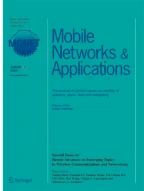Abstract
This paper describes the Flexible Interconnection Protocol, or FLIP, whose main goal is to allow interconnection of heterogeneous devices with varying power, processing, and communication capabilities, ranging from simple sensors to more powerful computing devices such as laptops and desktops. The vision is that FLIP will be used to interconnect such devices forming clouds in the farthest branches/leaves of the Internet, while still providing connectivity with the existing IP-based Internet infrastructure. Through its flexible, customizable headers FLIP integrates just the functions required by a given application and that can be handled by the underlying device. Simple devices like sensors will benefit from incurring close to optimal overhead saving not only bandwidth, but, more importantly, energy. More sophisticated devices in the cloud can be responsible for implementing more complex functions like reliable/ordered data delivery, communication with other device clouds and with the IP infrastructure.
FLIP is designed to provide a basic substrate on which to build network- and transport-level functionality. In heterogeneous environments, FLIP allows devices with varying capabilities to coexist and interoperate under the same network infrastructure. We present the basic design of FLIP and describe its implementation under Linux. We also report on FLIP's performance when providing IPv4 and IPv6 as well as transport-layer functionality a la TCP and UDP. We show FLIP's energy efficiency in different sensor network scenarios. For example, we use FLIP to implement the directed diffusion communication paradigm and obtain an improvement of 50% in energy savings over an existing directed diffusion implementation. Finally, we showcase FLIP's flexibility by demonstrating its ability to incorporate new protocol functions seamlessly. In particular, we add data aggregation functionality onto FLIP and show that it significantly increases the system's energy efficiency.
Similar content being viewed by others
References
M.D. Addlesee, A.H. Jones, F. Livesey and F.S. Samaria, The ORL active floor, IEEE Personal Communications 4(5) (1997) 35–41.
K. Almeroth, K. Obraczka and D. De Lucia, A lightweigth protocol for interconnecting heterogeneous devices in dynamic environments, in: Proceedings of the International Conference on Multimedia Computing and Systems (ICMCS), IEEE (June 1999).
F. Benner, D. Clarke, J. Evans, A. Hopper, A. Jones and D. Leask, Piconet: Embedded mobile networking, IEEE Personal Communications 4(5) (1997) 8–15.
Bluetooth Project, Bluetooth specification, http://www. bluetooth.com/dev/specifications.asp (2003).
DARPA, http://www.darpa.mil/ito/solicitations/glomo/glomobrief.html (February 1995).
S.E. Deering and R. Hinden, Internet Protocol, version 6 (IPv6) specification, IETF RFC-1883 (December 1995).
M. Degermark, M. Engan, B. Norgreen and S. Pink, Low-loss TCP/IP header compression for wireless networks, in: International Conference on Mobile Computing and Networking (MobiCom), ACM (November 1996).
M. Degermark, B. Nordgren and S. Pink, IP header compression, RFC-2507 (February 1999).
J. Elson and D. Estrin, An address-free architecture for dynamic sensor networks, Technical Report 00-724, Computer Science Department USC (January 2000).
A. Harter and F. Bennett, Low bandwidth infra-red networks and protocols for mobile communicating devices, Olivetti Research Laboratory Technical Report (May 1993).
IETF, http://www.ietf.org/html.charters/manet-charter. html (July 2000).
C. Intanagonwiwat, R. Govindan and D. Estrin, Directed diffusion: A scalable and robust communication paradigm for sensor networks, in: Proceedings of the International Conference on Mobile Computing and Networking (MobiCom), ACM (August 2000).
R. Katz et al., The daedalus project, http://daedalus.cs. berkeley.edu/ (January 1996).
J. Lilley, J. Yang, H. Balakrishnan and S. Seshan, A unified header compression framework for low-bandwidth links, in: International Conference on Mobile Computing and Networking (MobiCom), ACM (August 2000).
P. Osborn, G. Girling, J. Li Kam Wa and R. Stefanova, The pen low power protocol stack, in: Proceedings of the 9th IEEE International Conference on Computer Communications and Networks, ftp.uk. research.att.com:/pub/docs/att/tr.2000.12.pdf (October 2000).
Packet radio topics in professional journals, http://www.tapr. org/tapr/html/biblio.html (August 2000).
J.B. Postel, User Datagram Protocol, Technical Report RFC-768, IETF (August 1980).
J.B. Postel, Internet Protocol specification, Technical Report RFC-791, IETF (September 1981).
J.B. Postel, Transmission Control Protocol, Technical Report RFC-793, IETF (September 1981).
G. Pottie and W. Kaiser, Wireless integrated network sensors, Communications of the ACM 43(5) (2000).
H. Schulzrinne, S. Casner, R. Frederick and V. Jacobson, RTP: A transport protocol for real-time applications, Technical Report RFC-1889, IETF (January 1996).
I. Solis, J. Marcos and K. Obraczka, FLIP: a flexible protocol for efficient communication between heterogeneous devices, in: Proceedings of the IEEE Symposium on Computers and Communications (ISCC) (July 2001).
The VINT Group, VINT: virtual internet testbed, http://netweb. usc.edu/vint (1996).
USC/ISI, SCADDS: Scalable Coordination Architectures for Deeply Distributed Systems, http://www.isi.edu/scadds/ (November 2001).
USC/ISI, UCLA, Virginia Tech., Dynamic sensor networks (DSN), http://www.east.isi.edu/DIV10/dsn/ (August 2000).
R. Want, A. Hopper, V. Falcao and J. Gibbons, The active badge location system, ACM Transactions on Information Systems 10(1) (1992) 91–102.
M. Weiser, Research reports of the infrastructure for ubiquitous computing project, http://www.ubiq.com/weiser/researchreports.htm (March 1996).
M. Weiser, Ubiquitous computing, http://www.ubiq.com/hypertext/weiser/weiser.html
Author information
Authors and Affiliations
Rights and permissions
About this article
Cite this article
Solis, I., Obraczka, K. FLIP: A Flexible Interconnection Protocol for Heterogeneous Internetworking. Mobile Networks and Applications 9, 347–361 (2004). https://doi.org/10.1023/B:MONE.0000031603.28679.6f
Issue Date:
DOI: https://doi.org/10.1023/B:MONE.0000031603.28679.6f
